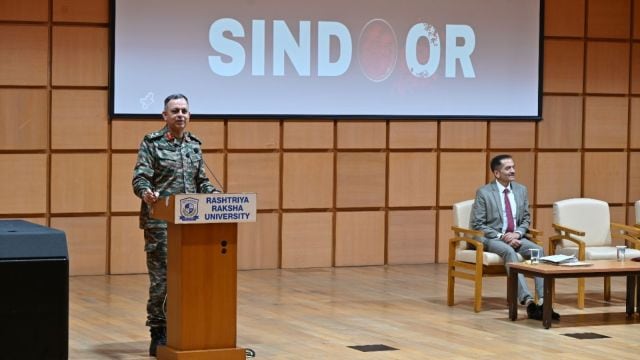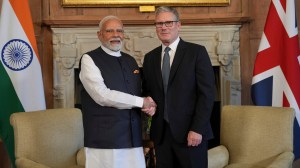Akash, Brahmos now battle-tested; counter-drone ops will remain expensive: Maj Gen Bagga on Operation Sindoor
In a roughly hour-long lecture to students and faculty members at RRU, Maj Gen Bagga highlighted the threat of information warfare and narrative shaping, the need for greater self-reliance in weapon technologies and the asymmetry caused by cheap armed drones in modern warfare.
 Maj Gen Gaurav Bagga has been delivering lectures at several universities and higher educational institutions on Operation Sindoor. (Express Photo)
Maj Gen Gaurav Bagga has been delivering lectures at several universities and higher educational institutions on Operation Sindoor. (Express Photo) While the lower house of Parliament on Monday morning began a 16-hour debate on Operation Sindoor and the events following the terrorist attack at Jammu and Kashmir’s Pahalgam in April this year, Major General Gaurav Bagga, the General Officer Commanding (GOC) of Golden Katar Division, spoke on the same topic at the Rashtriya Raksha University (RRU) in Gandhinagar.
Bagga has been delivering lectures at several universities and higher educational institutions on Operation Sindoor. After a lecture at Karnavati University and RRU, the Major General is set to speak at IIMA on July 30, said an Army spokesperson.
In a roughly hour-long lecture to students and faculty members at RRU, Bagga highlighted the threat of information warfare and narrative shaping, the need for greater self-reliance in weapon technologies and the asymmetry caused by cheap armed drones in modern warfare. From expounding on the Islamisation of the Pakistani Army to his thoughts on a multi-front war, Bagga touched on a number of topics, including how long deployed weapons in India’s arsenal had finally seen combat for the first time.
“A lot of systems, which were never (battle) tested, got tested. Akash was made, but never tested. Now it’s battle-hardened. They’ve been pretty successful. Brahmos missile was made, jointly manufactured with Russia, but never tested. They got tested. The S-400 was bought and deployed, but never tested. The scores of drones and anti-drone systems, many in trial stages, were tested and so Operation Sindoor has had several advantages for the armed forces. Many cannot be put in an open domain as yet,” said Major General Bagga.
Here he was referring to the Akash Surface-To-Air (SAM) missile system developed by the Defence Research and Development Organisation (DRDO) that is an integral part of India’s Air Defence shield. The S-400 missile system is another air defence system, this one imported from Russia. The Brahmos, meanwhile, is a supersonic cruise missile used in offence operations and is deployed with all three wings of the Indian military.
Taking a question on indigenisation of weapons systems, Bagga said, “Self-dependence or ‘atmanirbharta’ has come to the fore. If you remember, during Operation Vijay (1999 Kargil war), there was a challenge of ammunition shortage. It was not indigenous and we had to procure it from the world market. The 155-mm howitzer ammunition was not available and that was the first time we felt, in the middle of a war, that ammunition was not available. Atmanirbharta is thus a challenge we need to work on.”
On modern warfare, often conducted beyond visual range, Bagga said, “We are adapting to a new type of warfare because this time, nobody crossed the line of control, it was all by air. The whole battle changed and went towards a zone we had not anticipated in numbers and intensity. These are lessons we have learnt as a nation. Your security is directly proportional to the money you invest in it. To keep such a huge armed forces is an expensive business so that country has to balance and it is doing that.”
On India’s preparedness for a multi-front war, Bagga said, “Multi-front war is a reality, and to the best of our abilities, we are ready. Capability development is a constant process, it is a very slow and long-drawn process, which is happening. Human resources are being built, trained and a lot of situations and scenarios are being played up during preparation.”
He further added, “Preparation is a direct function of the kind of resources you have, the kind of supply chain that runs from many countries. So if we have a long-drawn war, we will have to look to friendly foreign countries where we will get our logistics supplies. That happens to be a challenge we are overcoming through ‘atmanirbharta’.”
On a question on the asymmetry between expensive anti-drone weapon systems and the relatively cheap attack drones used in modern warfare, Bagga said, “The anti-drone systems involve many things. It has a soft kill and a hard kill. Soft kills have ranges of 70-80 km unlike missiles whose ranges vary from 200-300-400 km… there is no refuting the fact that a small Chinese or Turkish drone is being countered by a missile. But that’s how it is. Now the question is do we have a cheap missile? We don’t. Do we have a cheap system that can hit at long ranges? We don’t. Should we allow that armed drone to come in and hope that our close-in systems will be able to (counter it)? These challenges remain, and that is why people are switching to lower-cost options like drones to cause damage. If you read about the Russia-Ukraine war, you will see most of the successful operations being done by drones because they are low-cost.”
Speaking about drone warfare during the short India-Pakistan conflict, Maj Gen Bagga said, “It’s not just the Pakistanis who did it. We did the same to them and they didn’t even have a counter for them (our drones). How did we reach their Lahore airport? It was our loitering munitions. At least we had counters, we did not allow them to damage any of our critical assets, including population centres or military stations. Counter (drone operations) will be more expensive till we get a cheaper option and no cheaper option is on the horizon (at the moment).”
He also talked about the initial targeting of terrorist camps across the border in the first phase of Operation Sindoor. “India’s western front stretches from Point NJ9842 at Siachen Glacier to Sir Creek in Gujarat. (When hostilities take place) we are supposed to work in a particular fashion. This time, the challenge was to do things not as we usually do. They were expecting us to reply in a particular way — which we did not do. The targets were not restricted to J&K. They were thinking that we would react in a certain way like we did after Uri. They expected something towards J&K, but we had different plans.”
“There was a pool of targets because the command and control element of the terrorists were there. From 21, ultimately 9 targets were chosen and based on certain factors, vectors were chosen. Seven were destroyed by the Indian Army, two by the Air Force and a communique was sent to Pakistan that this is what we wanted to do, and this is not related to your military or nation, but (this is) against terrorism. These (targets) included Sawai Nala, Syedna Bilal, Kotli Abbas, Kotli Gulpur, and Bhimber in POJK; and Bahawalpur, Muridke, Mehmoona Joya, and Sarjal in Pakistan,” he added.
On selection of targets, Bagga said, “The camps are far more than 21, but we selected them because at that point in time, they were active. The others may also not exist after our strikes because the terrorists need to have flexibility to move. They were not expecting Muridke and Bahawalpur, which had been terrorism headquarters for many years, to be hit. The network is flexible and in motion. When nine were hit, the other 12 weren’t there anymore. ”
Speaking on the state of the Pakistan Army, Major General Bagga said, “The islamisation of the Pakistan Army began when Zia-Ul-Haq was in power in the 1980s. Armies of all countries are apolitical and have no religion. He islamicised the Army and once you do that, the whole outlook changes. Then, the eastern neighbour becomes the Hindu eastern neighbour and that gives you a different dynamic.”
Bagga added, “Pakistan has troubles on its own western borders. On one hand there is Balochistan, and on the other, there is KPK (Khyber Pakhtunkhwa). They are in tumult and they must fight. The Pakistan Army is always under pressure because in Balochistan there are operations being carried out against the Pakistani Army every day. And when the Pakistani Army comes under pressure, they look to India. In India they can’t do much anywhere, so they go to J&K and carry out terrorist attacks through Hafiz Saeed of the LeT and Masood Azhar of the JeM.”
The Major General also said lack of employment and development in J&K was definitely not the cause for conflict or terror in the area.
On the political situation in Pakistan, Bagga further said, “There is an issue whenever there is greater political assertiveness in Pakistan. Whoever becomes stronger, put him in jail or hang him — that’s what Pakistan does. The moment Imran Khan became a little stronger and began questioning the Army, and the people began fighting them, he went to jail.”












